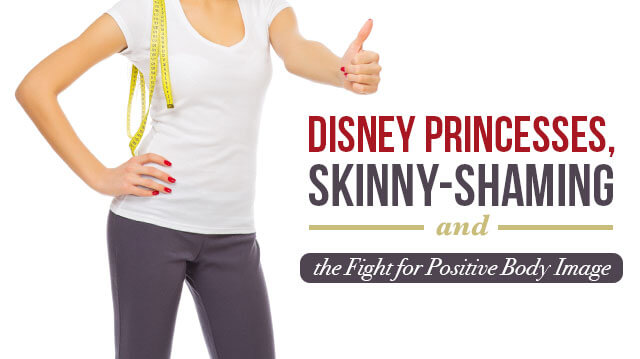
We are far more than our outward appearances. Despite this fact, it seems that we — and society as a whole — just can’t get over what we look like: what we choose to wear, what we weigh, whether or not we have tattoos. Even Disney princesses can’t escape the critical eye of society. Is it possible that we do more harm than good when we try to enforce a “normal” image on others — including fictional characters?
Can we define positive body image?
Ohio State University published a study titled “‘But I Like My Body’: Positive body image characteristics and a holistic model for young-adult women.” The study offered forth individual characteristics that exemplify positive body image. People with a healthy body image exhibit the following traits:
—Possess love and respect for the unique beauty of their body and the functions it performs.
—Accept and admire their body, even when their physical characteristics are inconsistent with idealized — dare we say Photoshopped? — images.
—Feel comfortable, confident, beautiful and happy with their body.
—Make it a habit to emphasize their body’s assets rather than hide its imperfections.
—Possess a mindful connection with their body.
—Internalize most of the positive image messaging we are barraged with, while rejecting most of the negative messages.
The National Eating Disorders Association (NEDA) carefully points out that our body size, body shape, weight and bone structure are influenced by genetics. You may have noticed that your body has a natural weight that it comfortably settles into when you’re not trying to lose — or gain — weight. This is natural.
 We’ll admit that Disney princesses are anything but natural, but they’re also cartoon characters. In an article written for Women’s Health last month, author Lisa Chudnofsky wrote an op-ed about the trend of modifying Disney princesses. Belle, Pocahontas and others are ironically Photoshopped to have realistic waistlines, makeup free faces, mom bods, or just “normal-sized eyes.” While the images are meant to encourage a message that girls need not aspire to such unrealistic images, it doesn’t do much in the fight for positive body image.
We’ll admit that Disney princesses are anything but natural, but they’re also cartoon characters. In an article written for Women’s Health last month, author Lisa Chudnofsky wrote an op-ed about the trend of modifying Disney princesses. Belle, Pocahontas and others are ironically Photoshopped to have realistic waistlines, makeup free faces, mom bods, or just “normal-sized eyes.” While the images are meant to encourage a message that girls need not aspire to such unrealistic images, it doesn’t do much in the fight for positive body image.
“Thing is,” Chudnofsky writes, “young women are pretty hip to the fact that these heroines are just that: fictional, animated characters.” Magazine covers, reality television and girls’ peers are the greater influences in terms of body image.
Dieting and media images
According to the National Association of Anorexia Nervosa and Associated Disorders (ANAD) “91 percent of women surveyed on a college campus had attempted to control their weight through dieting. Twenty-two percent dieted ‘often’ or ‘always.’” Further, 86 percent of women report having an eating disorder by the time they reach 20 years old, with 43 percent reporting an onset between 16 and 20.6 years of age.
A staggering 69 percent of girls in fifth through twelfth grade internalized and defined their ideal body image based on magazine pictures, which incidentally only represent five percent of American women.
Skinny-shaming is real
We often forget that body shaming comes in many forms. If you or someone you know is naturally very thin — or you’re one of those people who has to fight to keep weight on — skinny-shaming may not have escaped your notice.
A couple of years ago, The Guardian published an article titled “Why is skinny-shaming OK, if fat-shaming is not?” Author Emma Woolf retells having endured staff meetings at work where platters of edible goodies were piled high on the conference table, accompanied with encouraging comments from coworkers for her to eat more.
Woolf, who was anorexic at the time, recalled the interactions with a particular older coworker. “The fact that I was deeply anorexic and that she was overweight is irrelevant. She was drawing attention to my size in a way that would have been unacceptable had I done the same to her.”
She recognizes that she’s a thin person talking about an overweight person, “and yet — for a moment — think about how we describe thinness: skinny, angular, emaciated, bony skeletal, lollipop-head.” Images in the media reinforce these ideals to the extent that it can be dangerous.
The fight for our next generation of girls is ongoing. Of course we want to see images that are realistic and true to nature, but Photoshopping Disney princesses is a waste of resources. Not only do girls not base their self-image on Tiana, Elsa, Ariel or Mulan, but there’s also a subtle skinny-shaming element to giving princesses thicker waistlines. And that needs to stop.
In case no one has told you lately, you’re beautiful the way you are. We should all strive to be healthy and to be strong; don’t strive to look like some Photoshopped model on the cover of a magazine — even she doesn’t look like that in real life.
What do you think are some of the biggest challenges to maintaining a positive body image?
-Megan Winkler
Megan Winkler is an author, historian, Neurosculpting® meditation coach, certified nutritional consultant and DIY diva. When she’s not writing or teaching a class, Megan can be found in the water, on a yoga mat, learning a new instrument or singing karaoke. Her passion for a healthy mind-body-spirit relationship motivates her to explore all the natural world has to offer.
Sources:
http://www.researchgate.net/profile/Tracy_Tylka/publication/41428393_But_I_Like_My_Body_Positive_body_image_characteristics_and_a_holistic_model_for_young-adult_women/links/00463531b8aa4b66f8000000.pdf
http://www.womenshealthmag.com/life/photoshopping-disney-princesses
http://www.anad.org/get-information/about-eating-disorders/eating-disorders-statistics
http://www.nationaleatingdisorders.org/developing-and-maintaining-positive-body-image
http://www.theguardian.com/lifeandstyle/the-womens-blog-with-jane-martinson/2013/aug/05/skinny-shaming-fat-size-appearance

